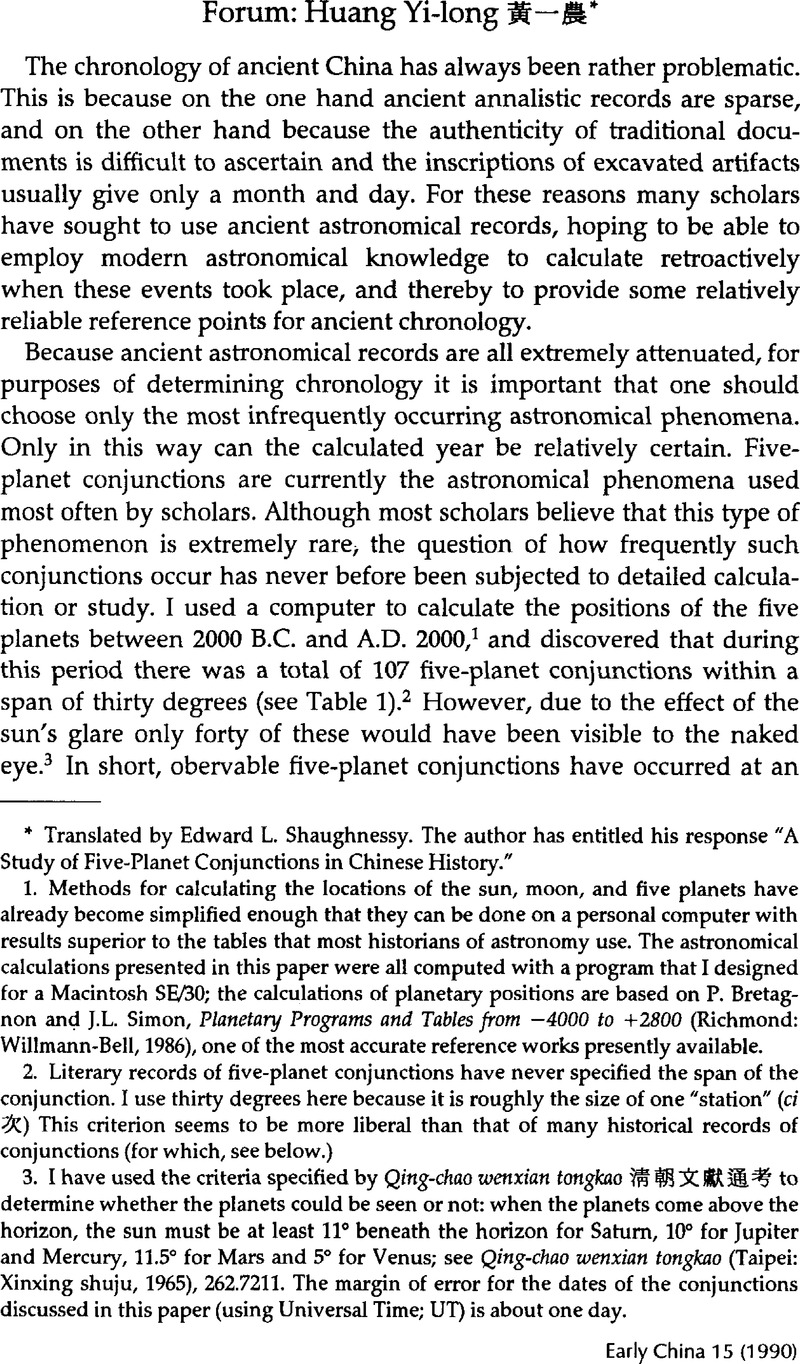Article contents
Forum: Huang Yi-long 黃一農*
Published online by Cambridge University Press: 26 March 2015
Abstract

- Type
- Forum
- Information
- Copyright
- Copyright © Society for the Study of Early China 1990
Footnotes
Translated by Edward L. Shaughnessy. The author has entitled his response “A Study of Five-Planet Conjunctions in Chinese History.”
References
1. Methods for calculating the locations of the sun, moon, and five planets have already become simplified enough that they can be done on a personal computer with results superior to the tables that most historians of astronomy use. The astronomical calculations presented in this paper were all computed with a program that I designed for a Macintosh SE/30; the calculations of planetary positions are based on Bretagnon, P. and Simon, J.L., Planetary Programs and Tables from — 4000 to + 2800 (Richmond: Willmann-Bell, 1986)Google Scholar, one of the most accurate reference works presently available.
2. Literary records of five-planet conjunctions have never specified the span of the conjunction. I use thirty degrees here because it is roughly the size of one “station” (ci 次) This criterion seems to be more liberal than that of many historical records of conjunctions (for which, see below.)
3. I have used the criteria specified by Qing-chao wenxian tongkao 淸朝文獻通考 to determine whether the planets could be seen or not: when the planets come above the horizon, the sun must be at least 11° beneath the horizon for Saturn, 10° for Jupiter and Mercury, 11.5° for Mars and 5° for Venus; see Qing-chao wenxian tongkao (Taipei: Xinxing shuju, 1965), 262.7211Google Scholar. The margin of error for the dates of the conjunctions discussed in this paper (using Universal Time; UT) is about one day.
4. Ancient astronomers generally did not have the astronomical knowledge needed to reconstruct accurately phenomena as remote as this. Taking the Han-dynasty “Santong li” 三統曆 or “Sifen li” 四分曆 for example, the calculations of each planet's revolution contained definite errors, so that calculations of planetary positions a thousand years earlier were often off by several lunar lodges; see Pingzi, Gao 高平子, “Han li wuxing zhouqi lun” 漢曆五星週期論, in Xue li sanlun 學曆散論 (Taipei: Institute of Mathematics, Academia Sinica, 1969), 259–304Google Scholar.
5. Pankenier, David W., “Astronomical Dates in Shang and Western Zhou,” Early China 7 (1982), 2–37CrossRefGoogle Scholar; “Mozi and the Dates of Xia, Shang and Zhou: A Research Note,” Early China 9–10 (1983–1985), 175–81Google Scholar.
6. Pankenier, , “Astronomical Dates”, citing Song shu 25.735–36Google Scholar.
7. Tianci's, Using Li 李天賜 “Xi-Han Zhong-Xi li duizhaobiao” 西漢中西曆對照表, included in Tian wen 天問, ed. Yuzhe, Zhang 張妊哲) (Nanjing: Jiangsu kexue jishu chubanshe, 1984), 156–221Google Scholar.
8. Han shu, 1A.22Google Scholar.
9. Wei shu 魏書, 48.1068Google Scholar. Nōda Chūryō ![]() also pointed out the error of this record; Tōyō temmongaku-shi ronsō 東洋天文學史論叢 (Tokyo: Kōseisha 恒星社, 1943), 338–349Google Scholar.
also pointed out the error of this record; Tōyō temmongaku-shi ronsō 東洋天文學史論叢 (Tokyo: Kōseisha 恒星社, 1943), 338–349Google Scholar.
10. Shiji 27.1348Google Scholar.
11. Williams, J., Observation of Comets from B.C. 611 to A.D. 1640 Extracted from the Chinese Annals (London: Strangeways and Walden, 1871)Google Scholar.
12. Qing-chao wenxian tongkao, 267.7252Google Scholar.
13. Jin shu 17.131Google Scholar.
14. Xin Tang shu, 27A.602–03Google Scholar.
15. In the summer of 1978, a fifth-century B.C. tomb was discovered in Suixian 隨縣, Hubei, containing a lacquer hamper on which were written the names of the twenty-eight lunar lodges. Among these names, Yingshi was written Xiying 西營 and Dongbi was written Dongying 東營, so that it is possible that the name Yingshi first appeared only somewhat later. See Jianmin, Wang 王健民, “Zhouli ershiba xing bian” 禮二十八星辨, in Zhongguo tianwenxue shi wenji 中國天文學史文集 (Beijing: Kexue chubanshe, 1984), vol. 3, 117–23Google Scholar.
16. Quoted in Taiping yulan 太平御覽 (rpt. Kyoto: Chu'o, 1980), 7.3Google Scholar.
17. See Chunfu, Lin 标春溥, Zhushu jinian buzheng 竹書紀年補證, in Zhushu jinian bazhong 竹書紀年八種 (Taipei: Shijie shuju, 1967), 1.17Google Scholar.
18. Pankenier, “Astronomical Dates.”
19. Jin shu, 12.322Google Scholar.
20. Quoted in Taiping yulan, 5.3Google Scholar.
21. Quoted in Tang Kaiyuan zhan jing 唐開元占經 (quanshu, Siku ed.), 19.2Google Scholar.
22. For this, see Taiping yulan, 84.5 and 329.5Google Scholar.
23. Song shu, 27.765Google Scholar.
24. Pankenier, “Astronomical Dates.”
25. See Fagao, Zhou 周法高, “Wuwang ke Shang de niandai wenti” 武王克商的年代問題, Bulletin of the Institute of History and Philology 56.1 (1985), 5–41Google Scholar.
26. Yuzhe, Zhang, “Halei huixing de guidao yanbian de chushi he tade gudai lishi” 哈雷彗星的軌道演變的趨勢和它的古代歷史, Tianwen xuebao 天文學報 19.1 (1978) 109–18Google Scholar; Guangxian, Zhao, “Cong tianxiang shang tuiduan Wuwang fa Zhou zhi nian” 從天象上推斷武王伐紂之年, Lishi yanjiu 歴史硏究 1979.10, 56–61Google Scholar.
27. See Yoke, Ho Peng, “Ancient and Mediaeval Observations of Comets and Novae in Chinese Sources”, Vistas in Astronomy 5 (1962), 127–225CrossRefGoogle Scholar.
28. Halley's Comet is by no means always very bright, as for instance on its most recent return when it was not easily seen by the naked eye. Moreover, even if what appeared at that time was an extremely prominent comet it would not necessarily be Halley's, since numerous other comets, whether of fixed periodicity or not, are often also quite bright.
29. Taiping yulan, 7.3Google Scholar. The Xiaojing gouming jue must have been completed before the time of Zheng Xuan 鄭玄 (127–200), since Zheng wrote a commentary to it.
30. Pang, K.D., Espenak, F., Huang, Y.-L., Chou, H.H. and Yau, K., “The Origin and Extent of Chinese Civilization: Inference from Ancient Astronomical Records”, Proceedings of the Fifth International Conference on the History of Chinese Science (San Diego, CA, 1989)Google Scholar.
31. This result is based on my calculation of the daily relative positions of the five planets from 4000 B.C. through A.D. 2000.
32. Pankenier, “Mozi and the Dates.”
33. “Qian xiang dian” (Gujin tushu jicheng ed.), j. 50.
34. These records can be found in Xu Tong zhi 續通志 (Taipei: Xinxing shuju, 1965) 171.4297Google Scholar, and in Qingchao wenxian tongkao, 267.7252Google Scholar.
35. Shiji, 27.1320–21Google Scholar.
- 4
- Cited by




